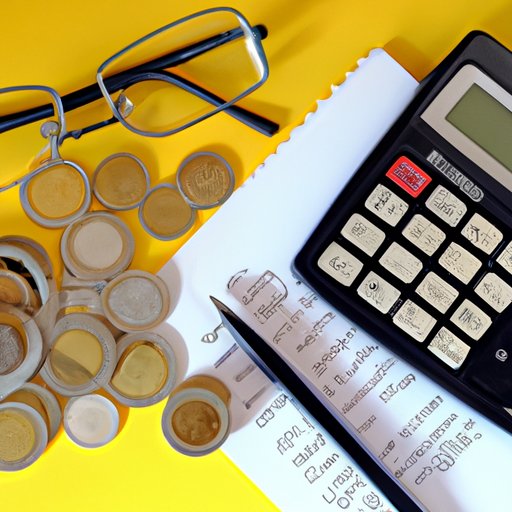Introduction
Developing a personal financial plan is crucial to achieving your financial goals, reducing stress, and achieving financial stability. In this article, we’ll discuss seven simple steps to help you develop your own personal financial plan.
Our topics will include assessing your current financial situation, creating a budget, paying off debt, building an emergency fund, saving for retirement, and investing in your future. Additionally, we’ll cover the importance of having a roadmap for your personal finances and ways to maximize your money.
7 Simple Steps to Develop Your Personal Financial Plan
Step 1: Determine your goals
The first step in developing a personal financial plan is to determine your financial goals. These goals can range from saving for a purchase, like a car or house, to building an emergency fund or saving for retirement.
Take some time to reflect on what’s important to you financially and what you’d like to achieve in the short and long term. From there, you can begin to develop a plan of action.
Step 2: Assess your current financial situation
Once you’ve determined your goals, it’s important to assess your current financial situation. This includes taking a look at your income, expenses, and debts.
Make a list of all your current debts, including balances and interest rates. From there, you can create a plan to pay off the debt with the highest interest rate first.
Step 3: Create a budget
Creating a budget is essential to managing your finances effectively. Start by tracking your expenses for a month. This will allow you to see where your money is going and where adjustments can be made.
Once you have an idea of your typical monthly expenses, create a budget that accounts for savings, debt payments, and regular expenses like rent or mortgage payments, groceries, and utility bills.
Step 4: Pay off debt
Paying off debt is an important step in achieving financial stability. Once you have a budget in place, you can start to allocate extra funds toward paying off your debt.
As we mentioned earlier, prioritize paying off the debt with the highest interest rate first. Once that’s paid off, move on to the next debt on your list.
Step 5: Build an emergency fund
Building an emergency fund is crucial to financial stability. Aim to save three to six months’ worth of living expenses in an emergency fund.
To start, set aside a portion of each paycheck into a savings account specifically designated for emergencies. Once you’ve built up your emergency fund, you can focus on other savings goals.
Step 6: Start saving for retirement
It’s never too early (or late) to start saving for retirement. Consider setting up a retirement account, such as an individual retirement account (IRA) or a 401(k) through your employer.
If your employer offers a retirement savings plan, take advantage of any matching contributions they offer. This is essentially free money for your retirement savings.
Step 7: Invest in your future
Once you’ve made progress on paying off debt, building an emergency fund, and saving for retirement, consider investing in your future to achieve other financial goals, such as buying a home or starting a business.
Do your research and consider consulting a financial advisor to help you make informed investment decisions that align with your goals and risk tolerance.
Creating a Personal Finance Roadmap: Tips to Get Started
Creating a roadmap for your personal finances is essential to achieving your financial goals and increasing financial stability.
Start by defining your financial goals, tracking your expenses, and creating a budget. From there, prioritize paying off debt and building an emergency fund. Once those goals are achieved, focus on saving for retirement and investing in your future.
Maximizing Your Money: Crafting a Personal Financial Plan
Maximizing your money involves finding ways to save money and cut expenses. This includes making a plan for big purchases, like a car or home, and finding ways to save on regular expenses like groceries and utilities.
For example, consider buying a used car rather than a new one to save money. Additionally, look for ways to reduce your utility bills, such as turning off lights and unplugging electronics when they’re not in use.
The Importance of a Personal Financial Plan and How to Make One
Having a personal financial plan is crucial to achieving financial stability and reducing stress. A plan can help you stay on track and make informed financial decisions.
To develop a personal financial plan, start by setting financial goals and tracking your expenses. Use online tools and consult with professionals, such as financial advisors and accountants, to help create a comprehensive plan that aligns with your goals and risk tolerance.
From Budgeting to Investing: How to Develop Your Personal Financial Plan
A personal financial plan involves budgeting, saving, and investing. To set yourself up for financial success, define your financial goals, assess your current financial situation, and create a budget that accounts for savings, debt payments, and regular expenses.
Next, prioritize paying off debt and building an emergency fund. Once those goals are achieved, focus on saving for retirement and investing in your future. Consult with professionals, like financial advisors and accountants, to help make informed investment decisions.
Conclusion
Developing a personal financial plan is critical to achieving financial stability and reducing stress. By following the seven simple steps outlined in this article, you can create a comprehensive plan that aligns with your goals and risk tolerance.
Remember to create a roadmap for your personal finances, maximize your money, and seek help from professionals when needed. With a solid plan in place, you can achieve your financial goals and enjoy greater peace of mind.
(Note: Is this article not meeting your expectations? Do you have knowledge or insights to share? Unlock new opportunities and expand your reach by joining our authors team. Click Registration to join us and share your expertise with our readers.)
